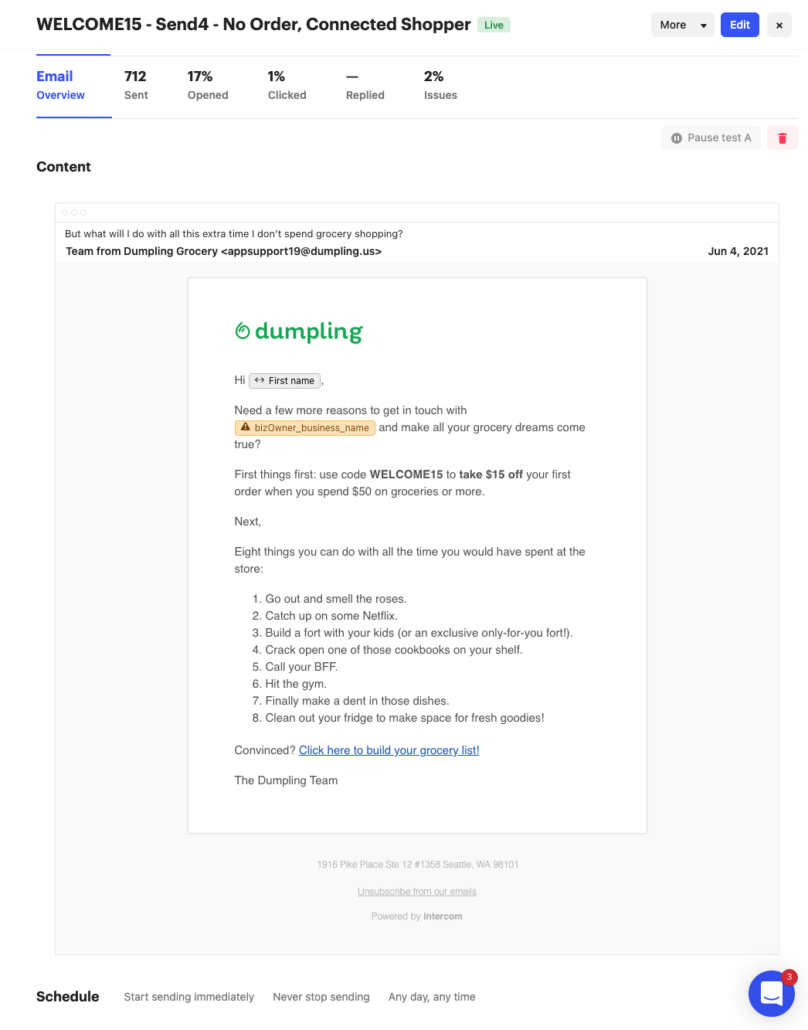A Hill We’ll Die On: Email is Critical to Your CRO
Email marketing is a crucial way of keeping your audience engaged. Full stop. No matter if you’re an eCommerce or SaaS, B2B or B2C, email is an incredibly powerful tool that can move users through the funnel and help them pick up steam on the way towards conversion.
That’s why the way we think about email needs to change.
If your strongest association with email involves things like newsletters and announcements, you’re definitely not alone. But if we accomplish anything with this article, it will be helping you shift your perspective so you think of email as a powerful tool for conversion rate optimization (CRO). Since email is an intimate way of communicating with your customers, it is the perfect way to drive conversions.
Whether someone signs up for your email list at a conference, exchanges it for gated content, enters a giveaway, or joins your list after making a purchase, they are already familiar with your brand. That’s what positions it on a pedestal high above discovery-based channels like social media (although of course, social plays a different but equally important role).
Let’s talk about how to do some marketing alchemy and turn that familiarity into conversions.
A note on newsletters
Before diving deeper into how email can be used as a CRO tool, it’s important to note that newsletters (while, true, we might have talked some smack above) are also a super important part of your overall strategies.
Once you add someone to your email list, maintaining regular communication with them is essential. Doing so “trains” your audience to look for updates and keeps your brand top of mind.
Newsletter emails are also a great way to optimize your calls-to-action (CTA) by tracking how customers interact with them.
In an attempt to avoid confusion for the intent of this article:
- There is a CRO component to newsletters (button type, subject lines, actionable copy, etc) but that’s NOT what we’re talking about here.
- Thinking about super targeted emails that communicate with your customer as a touchpoint in their bigger-picture path towards conversion IS what where talking about here.
Step #1: Map Out the Customer Journey
The first step to turning email into a powerful CRO tool is by putting yourself in your audiences’ shoes.
While email acquisition is its whole separate strategic beast (we could—and will!—write a fully separate post on this topic) it’s important to think about the different ways people jump onto your email list.
So, on that note, before you think about creating CRO-focused email flows, put your heads together with your marketing team to dig in and map out what your customer journeys look like. This includes answering questions like:
- What are the myriad ways someone might give us their email address?
- How long does it take cold traffic to convert?
- Is there a seasonality to buying?
- How is our sales team involved and how can we avoid duplicate messaging?
Once do the legwork here and get these down on paper (or mapped out on a white board) it will make segmentation much, much easier.
Step #2: Segment
In email marketing, there is no one-size-fits-all approach. It’s critical to clearly define your customers and create a personalized email strategy. To get the best results, segmentation is an important piece of the puzzle. That way we can target recipients based on factors like behavior and attributes and make email feel like a real part of a conversation as opposed to an impersonal blast.
Every business is different. (Stating the obvious, much?) Which means there’s no one blueprint to follow for segmentation. Hopefully once you’ve mapped out your user journeys, getting in and segmenting your users feels like a natural next step.
Here are the two most common ways to go about it:
Behavior
Behavior segmentation is a good way to target your audience based on how they will react to your emails. A few examples of behavior segmentation would be:
- When someone downloads your app but doesn’t create an account
- When someone downloads a white paper
- When someone abandons their cart
Analyzing how your customers behave on your website gives you valuable insight to help increase conversion rate optimization.
Attribute
Another way to segment your audience is by their attributes. This involves collecting user information either when they give you their email (the MUCH easier way to go about it) or in retrospect through surveys or other tactics (a good approach if you already have a large list of emails but don’t have much associated information).
Pro tip: Only ask for the most important information when collecting a user’s email address.
Tips for Segmenting Your Audience
Collect the least amount of/most relevant information as possible
As we mentioned earlier, people don’t want to take the time to give out more information than they need to. It takes more time for them to sign up and users don’t want to give out information if they are not absolutely sure about the value they’ll receive in return. Only ask for the most important data that will benefit the end user and help you segment.
Think about the fewest number of ways you can segment
Deciding the best way to segment your audience in order to drive maximum conversions can be the trickiest and most time-consuming piece of this equation. Our tip: don’t do it in a vacuum!
Segmenting your audience into fewer categories allows you to efficiently learn user behavior, run tests, and optimize your email strategy. Too many segments will waste resources and leave your approach scattered.
Just like customer journey mapping, segmenting your audience is a difficult undertaking, but doing it well makes the rest of the CRO process much easier.
Step #3: Get Detailed With Your Email Flows
The short story: the better your messaging speaks to your user that’s considerate of where they are in their customer journey, the more likely they will be to take the action you’d like them to take.
Based are where your segmented audiences are in their customer journey helps you decide how to set your goal for your email flow. Do you want a user to sign up for a premium plan? Buy a product? Continue to a landing page?
Guiding users to take action necessitates engagement and continuous reasons to stay subscribed (read: offers, awesome content, etc.). One of the most common (and worst) mistakes companies make is emailing too often or sending irrelevant emails without purpose. The last thing you want is the reader asking themselves “what’s the point of this email?”
For instance, an email to remind someone about an abandoned cart will look nothing like an email sent to someone that signed up for a coupon after seeing an ad.
While designing your flows, keep in mind that you’ll want to have a plan for what to do once a user reaches a goal. This might mean moving them into a new flow or putting them back on a general newsletter.
Pro tip: this is where it’s super easy to get overwhelmed by the number of possible flows you can create. We recommend starting with an email flow that targets a segment that’s most likely to buy (abandoned cart, quiz takers, and people that have recently joined your list) then refine, measure success, and scale from there.
Also, stay organized! We map out our users’ journeys in a spreadsheet, like this one.
Step #4: Create Really Great Emails
No matter how targeted your flow is, poorly designed emails won’t lead to conversions. The key to conversion rate optimization is creating really good emails.
Before you create an email, you should be able to answer these questions:
- What critical benefits do you want your user to know and in what order?
- What are the biggest blockers between your user and conversion?
- How can you meet them where they’re at and deliver a targeted, rock-solid message.
The hierarchy of messaging can make or break your flow. Your users not only need to receive the right information, they need to receive it in the right order.
Next, consider the obstacles between your audience and conversions. When designing your emails, think of ways to help users overcome these hurdles. (Think social proof, user testimonials, press mentions, or even “personalized” messages from your founder).
Finally, be sure to keep CTAs in mind. Every email should include a clear action for your audience to interact with. Even if users aren’t ready to make a purchase or subscribe to your service, peripheral CTAs can keep them engaged along the way.
Step #6: Analyze, Optimize, Rinse & Repeat
Once you have emails sending and your strategy in motion, the work isn’t quite done. The way your users interact with your emails can give you super valuable insights.
Consistently analyzing data like which links are most clicked, which subject lines drive the most opens, and which sends trigger the most unsubscribes should be leveraged on a monthly basis to drive design, copy, and flow.
Ultimately, odds are, your first email strategy won’t be as effective as you want and that’s okay. The important part is to trust the process, analyze the results, and optimize your strategy until you get the results you want.
In short, winning companies think about email as a CRO tool. By doing so, you can better optimize your communication strategy and generate more conversions compared to competitors that only see email as a way to talk to your audience.
Looking to supercharge your email strategy to drive conversions? Let’s chat about it!








